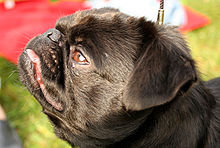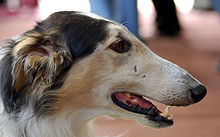- Cephalic index
-
Cephalic index is the ratio of the maximum width of the head multiplied by 100 divided by its maximum length (i.e., in the horizontal plane, or front to back).
The index was widely used by anthropologists in the early twentieth century to categorize human populations, and by Carleton S. Coon in the 1960s. Today it is mainly used to describe individuals' appearances and for estimating the age of fetuses for legal and obstetrical reasons.
The index is also used to categorize animals, especially dogs and cats.
Contents
Cephalic index in human anthropology
The cephalic index was defined by Swedish professor of anatomy Anders Retzius (1796–1860) and first used in physical anthropology to classify ancient human remains found in Europe. The theory became closely associated with the development of racial anthropology in the 19th and early 20th centuries, when prehistorians attempted to use ancient remains to model population movements in terms of racial categories.
Human populations were characterized as either dolichocephalic (long headed), mesaticephalic (moderate headed), or brachycephalic (broad headed).
The usefulness of the cephalic index was questioned by Giuseppe Sergi, who argued that cranial morphology provided a better means to model racial ancestry.[1] However Franz Boas studied the children of immigrants to the United States in 1910 to 1912, noting that the children's cephalic index differed significantly from their parents', implying that local environmental conditions had a significant impact on the development of head shape.[2]
Boas argued that if craniofacial features were so malleable in a single generation, then the cephalic index was of little use for defining race and mapping ancestral populations. Scholars such as Earnest A. Hooton continued to argue that both environment and heredity were involved. Boas did not himself claim it was totally plastic.
In 2002, a paper by Sparks and Jantz re-evaluated some of Boas' original data using new statistical techniques and concluded that there was a "relatively high genetic component" of head shape.[3] Ralph Holloway of Columbia University argues that the new research raises questions about whether the variations in skull shape have "adaptive meaning and whether, in fact, normalizing selection might be at work on the trait, where both extremes, hyperdolichocephaly and hyperbrachycephaly, are at a slight selective disadvantage."[2]
In 2003, anthropologists Clarence C. Gravlee, H. Russell Bernard, and William R. Leonard reanalyzed Boas' data and concluded that most of Boas' original findings were correct. Moreover, they applied new statistical, computer-assisted methods to Boas' data and discovered more evidence for cranial plasticity.[4]
In a later publication, Gravlee, Bernard and Leonard reviewed Sparks' and Jantz' analysis. They argue that Sparks and Jantz misrepresented Boas' claims, and that Sparks' and Jantz' data actually support Boas. For example, they point out that Sparks and Jantz look at changes in cranial size in relation to how long an individual has been in the United States in order to test the influence of the environment.
Boas, however, looked at changes in cranial size in relation to how long the mother had been in the United States. They argue that Boas' method is more useful, because the prenatal environment is a crucial developmental factor.[5]
Indices
Cephalic indices are grouped as in the following table:
Females Males Scientific term Meaning Alternative term < 75 < 75.9 dolichocephalic 'long-headed' 75 to 83 76 to 81 mesaticephalic 'medium-headed' mesocephalic; mesocranial > 83 > 81.1 brachycephalic 'short-headed' brachycranial Technically, the measured factors are defined as the maximum width of the bones that surround the head, above the supramastoid crest (behind the cheekbones), and the maximum length from the most easily noticed part of the glabella (between the eyebrows) to the most easily noticed point on the back part of the head.
Cephalic index in animal breeding
The cephalic index is used in the categorisation of animals, especially breeds of dogs and cats.
see Cephalic index in cats and dogs
Brachycephalic animals
 Brachycephalic Pug
Brachycephalic Pug
A brachycephalic skull is relatively broad and short (typically with the breadth at least 80% of the length). Dog breeds such as the pug are sometimes classified as "Extreme Brachycephalic".
Brachycephalic dogs and cats are very sensitive to high temperatures, making the choice of a sleep or travel crate surface especially important.[citation needed]
List of brachycephalic dogs:
- Affenpinscher
- American Bulldog
- Boston Terrier
- Boxer
- Brussels Griffon
- Bulldog
- Bullmastiff
- Cavalier King Charles Spaniel
- Cane Corso
- Dogo Argentino
- Dogue de Bordeaux
- English Toy Spaniel
- French Bulldog
- Japanese Chin
- Lhasa Apso
- Neapolitan Mastiff
- Pekingese
- Presa Canario
- Pug
- Rottweiler
- Shar-Pei
- Shih Tzu
- Tibetan Spaniel
- Valley Bulldog
- Chow Chow
-
This list is incomplete; you can help by expanding it.
List of brachycephalic cats:
- British Shorthair
- Himalayan cat
- Persian cat
- Exotic Shorthair
Mesaticephalic animals
 Mesocephalic Labrador Retriever
Mesocephalic Labrador Retriever
A mesaticephalic skull is of intermediate length and width. Mesaticephalic skulls are not markedly brachycephalic or dolichocephalic. (when dealing with animals, especially dogs the more appropriate and commonly used term is not 'mesocephalic', but is 'mesaticephalic' which is a ratio of head to nasal cavity. The breeds below exemplify this category. (see Evans, Howard. Miller's Anatomy of the Dog. 3rd edition, page 132 or http://medical-dictionary.thefreedictionary.com/mesaticephalic)
- American Pit Bull Terrier
- American Staffordshire Terrier
- Alaskan Malamute
- Australian Cattle Dog
- Beagle
- Bearded Collie
- Bichon Frisé
- Border Collie
- Brittany
- Cairn Terrier
- Dalmatian
- Doberman Pinscher
- Dogue de Bordeaux
- Golden Retriever
- German Shepherd Dog
- Irish Setter
- Labrador Retriever
- Neapolitan Mastiff
- Norwich Terrier
- Norfolk Terrier
- Pembroke Welsh Corgi
- Pomeranian
- Rottweiler
- Shar-Pei
- Staffordshire Bull Terrier
- St. Bernard
- Weimaraner
- West Highland White Terrier
- Yorkshire Terrier
-
This list is incomplete; you can help by expanding it.
Dolichocephalic animals
 Dolichocephalic Borzoi
Dolichocephalic Borzoi
A dolichocephalic skull is relatively long skull (typically with the breadth less than 80% or 75% of the length).
List of dolicocephalic canines:
- Afghan Hound
- Azawakh
- Bedlington Terrier
- Borzoi
- Chart Polski
- Cirneco dell'Etna
- Collie
- Dachshund
- English Bull Terrier
- Galgo Español
- Greyhound
- Hortaya Borzaya
- Ibizan Hound
- Irish Wolfhound
- Italian Greyhound
- Pharaoh Hound
- rough collie
- Saluki
- Scottish Deerhound
- Silken Windhound
- Sloughi
- Whippet
- Great Dane
- Siberian Husky
- Grey wolf
-
This list is incomplete; you can help by expanding it.
See also
Further reading
- Spiro, Jonathan P. (2009). Defending the Master Race: Conservation, Eugenics, and the Legacy of Madison Grant. Univ. of Vermont Press. ISBN 978-1-58465-715-6. Lay summary (29 September 2010).
External links
References
- ^ K. Killgrove (2005) (PDF). Bioarchaeology in the Roman World. M.A. Thesis, UNC Chapel Hill. Archived from the original on August 10 2011. http://www.webcitation.org/1312942436437570.
- ^ a b Ralph L. Holloway, Head to head with Boas: Did he err on the plasticity of head form?
- ^ Corey S. Sparks and Richard L. Jantz (November 2002). "A reassessment of human cranial plasticity: Boas revisited". PNAS 99 (23): 14636–14639. doi:10.1073/pnas.222389599. PMC 137471. PMID 12374854. http://www.pubmedcentral.nih.gov/articlerender.fcgi?tool=pmcentrez&artid=137471. Retrieved 2006-08-07.. See also the discussion in Ralph L. Holloway (November 2002). "Head to head with Boas: Did he err on the plasticity of head form?". PNAS 99 (23): 14622–14623. doi:10.1073/pnas.242622399. PMC 137467. PMID 12419854. http://www.pubmedcentral.nih.gov/articlerender.fcgi?tool=pmcentrez&artid=137467. Retrieved 2006-08-07.
- ^ http://lance.qualquant.net/gravleeetal03a.pdf
- ^ http://www.anthro.fsu.edu/people/faculty/CG_pubs/gravlee03b.pdf
Categories:- Physical anthropology
Wikimedia Foundation. 2010.
